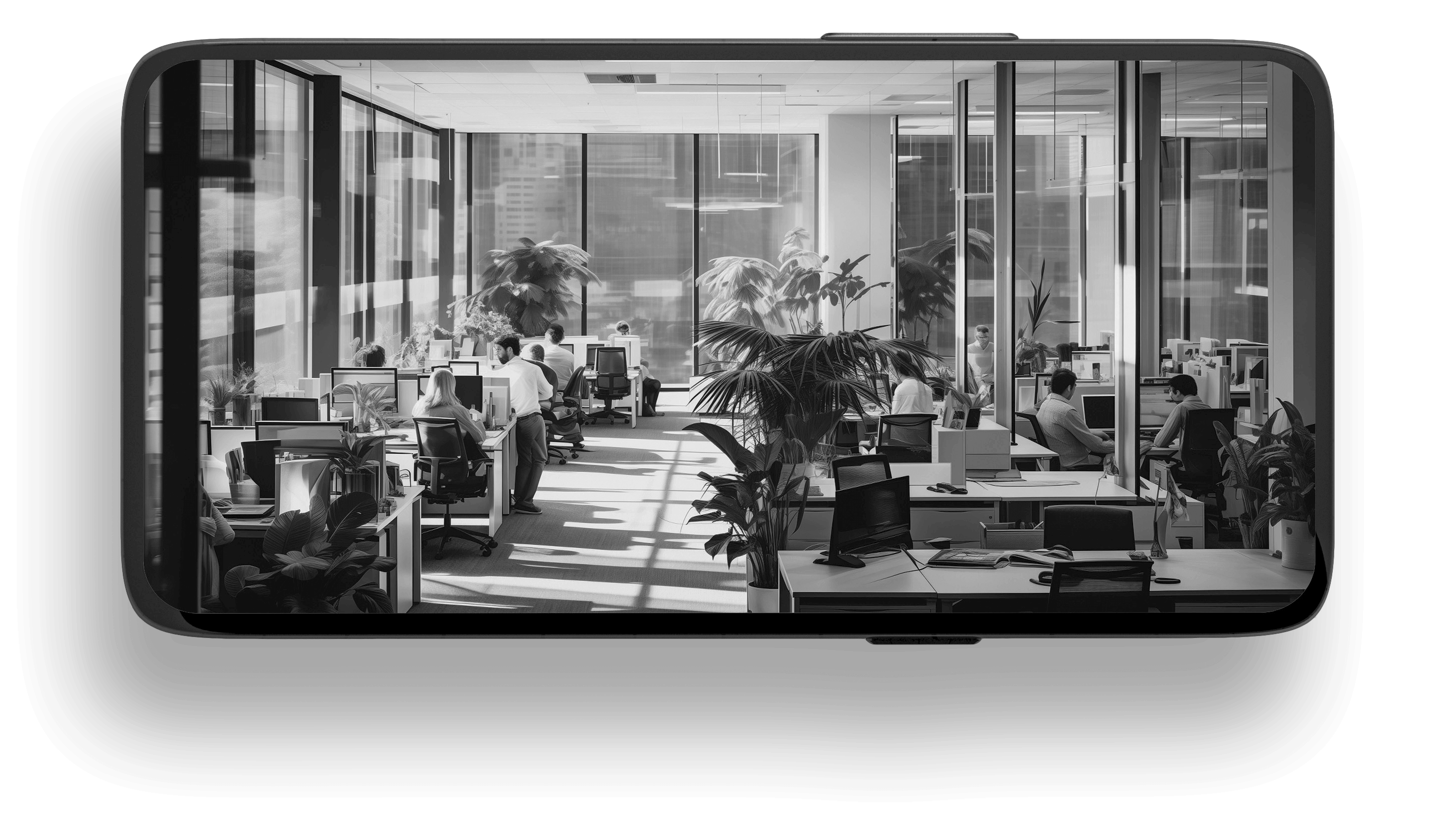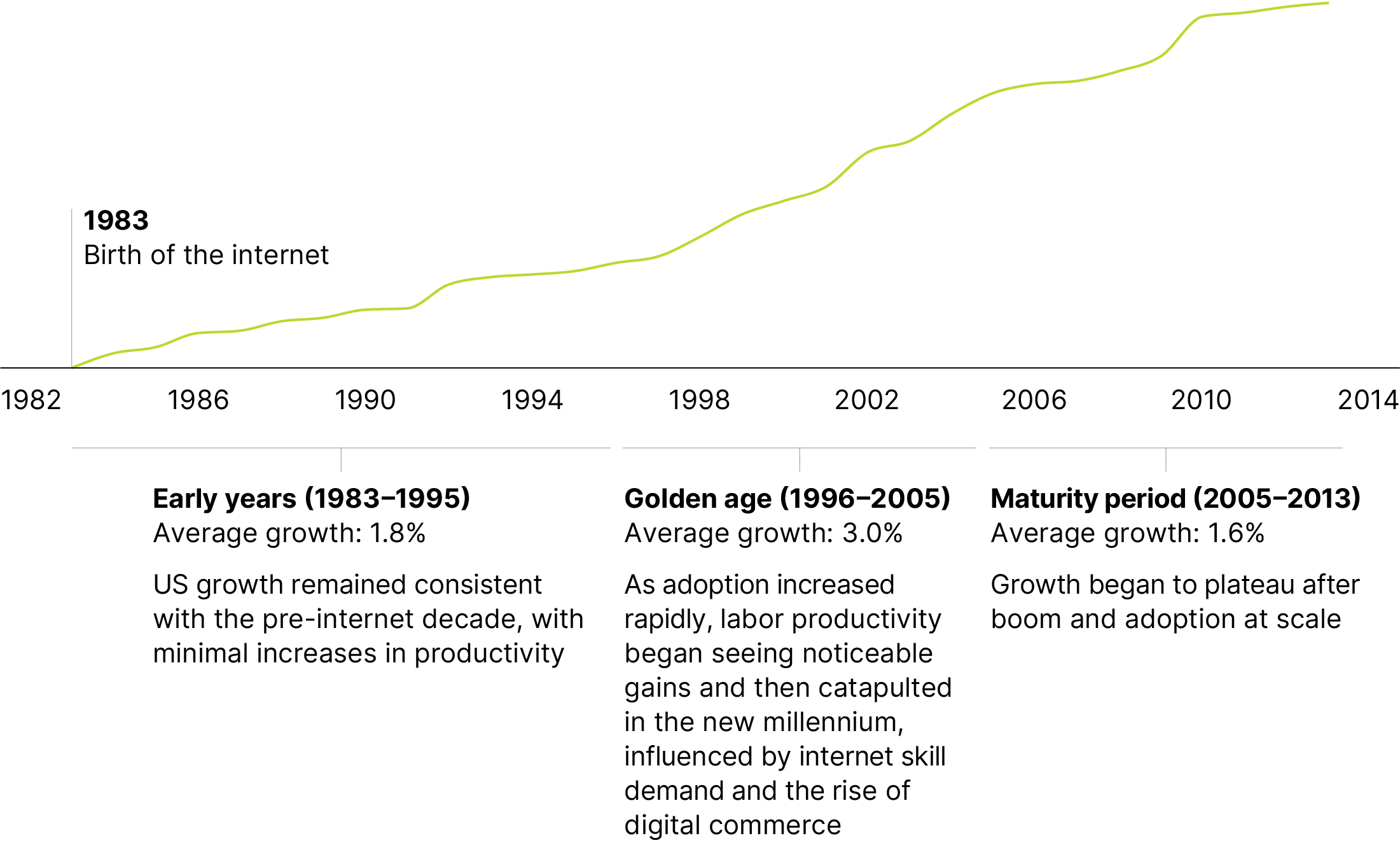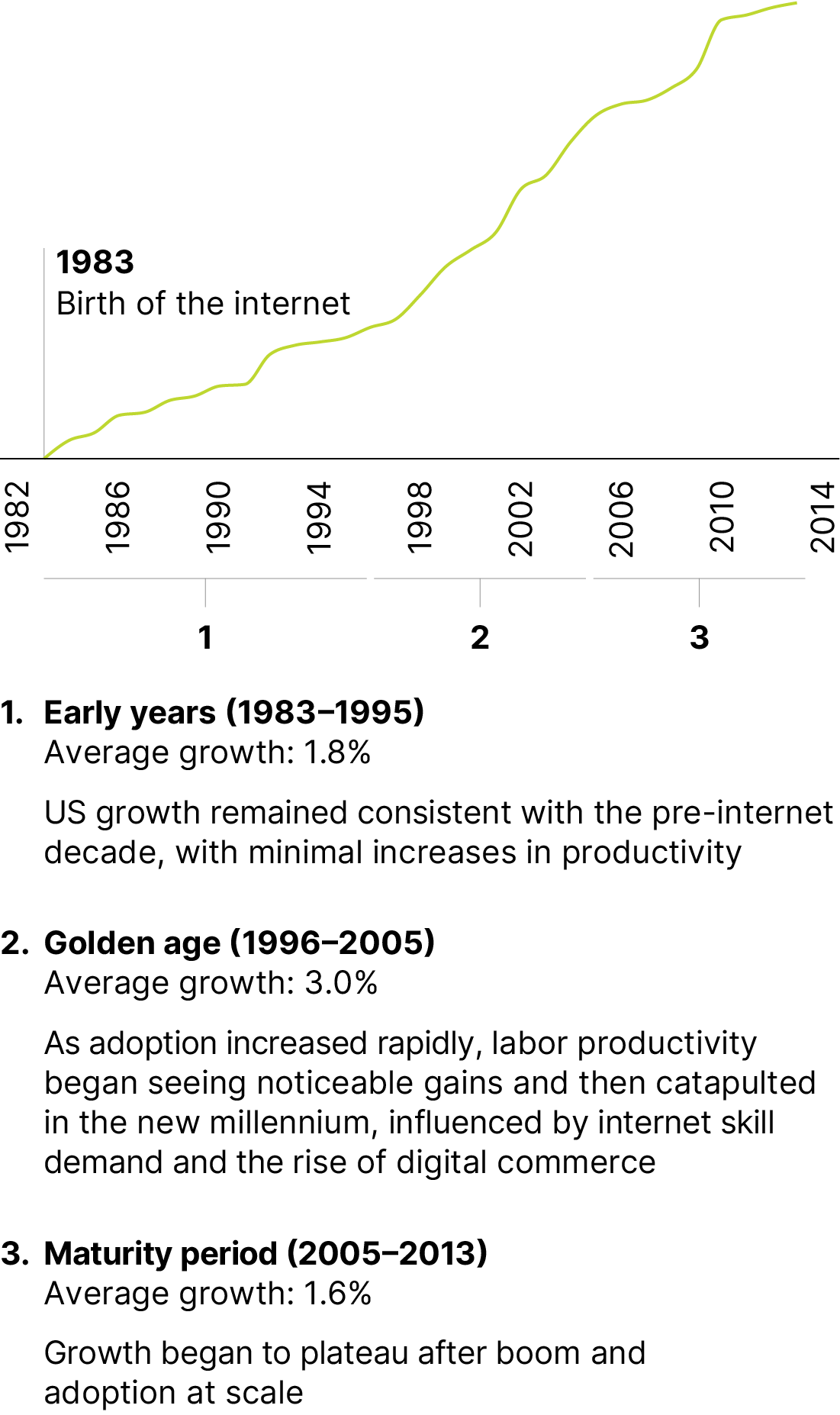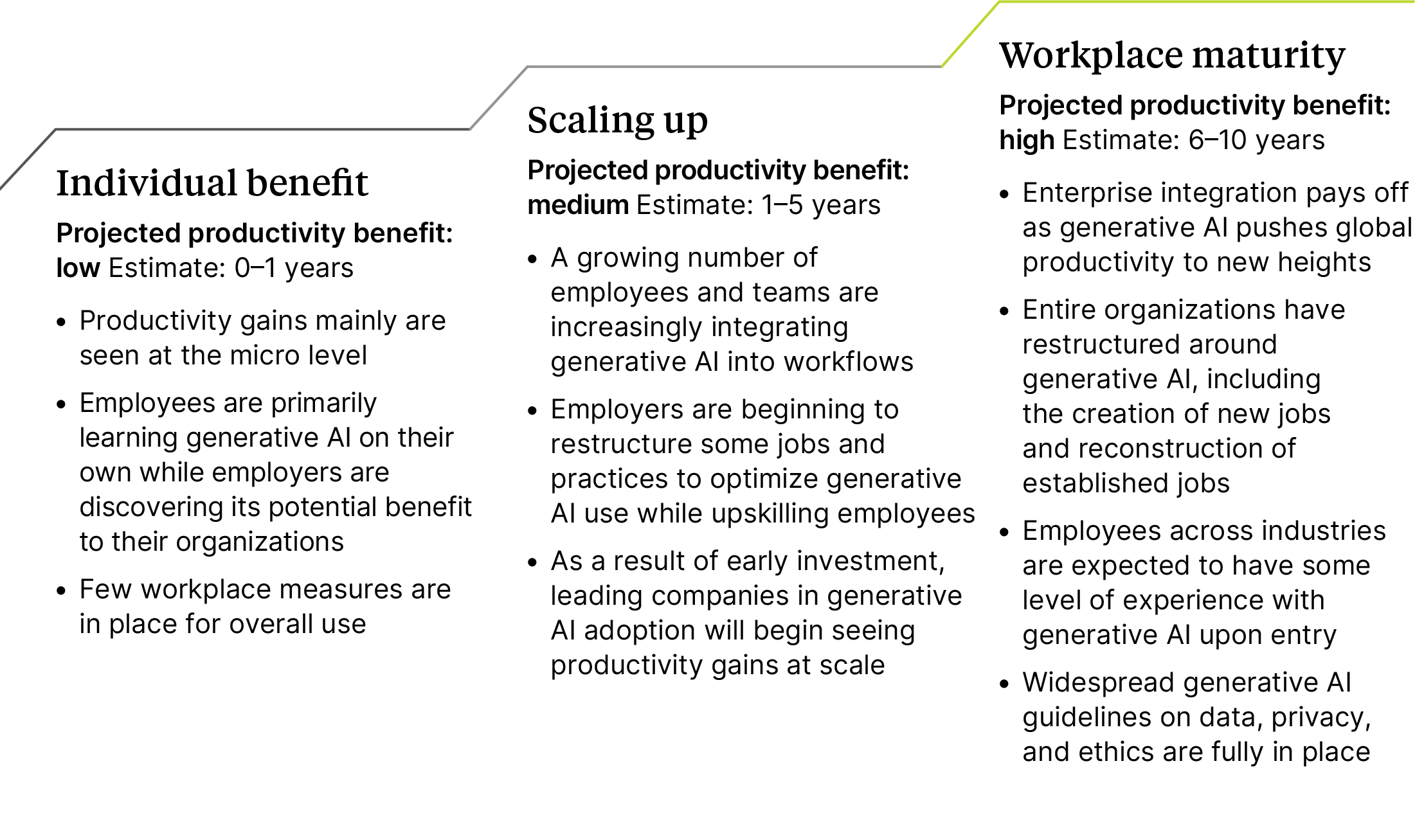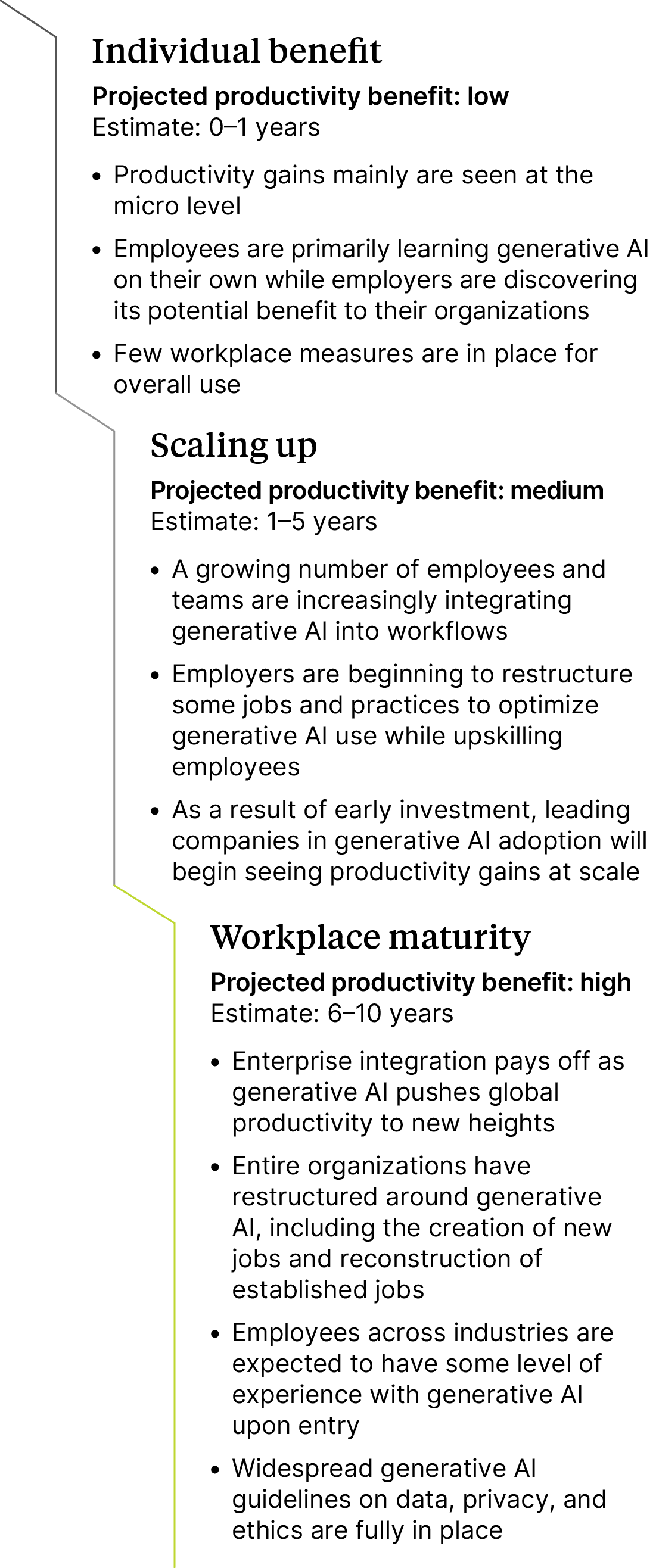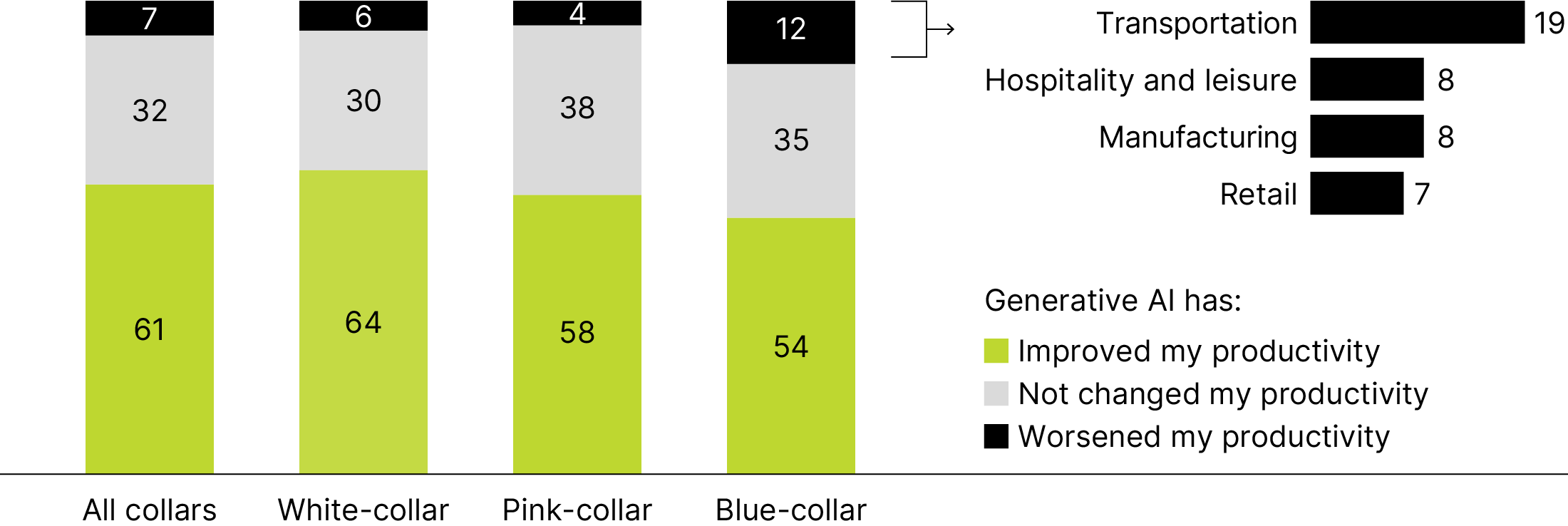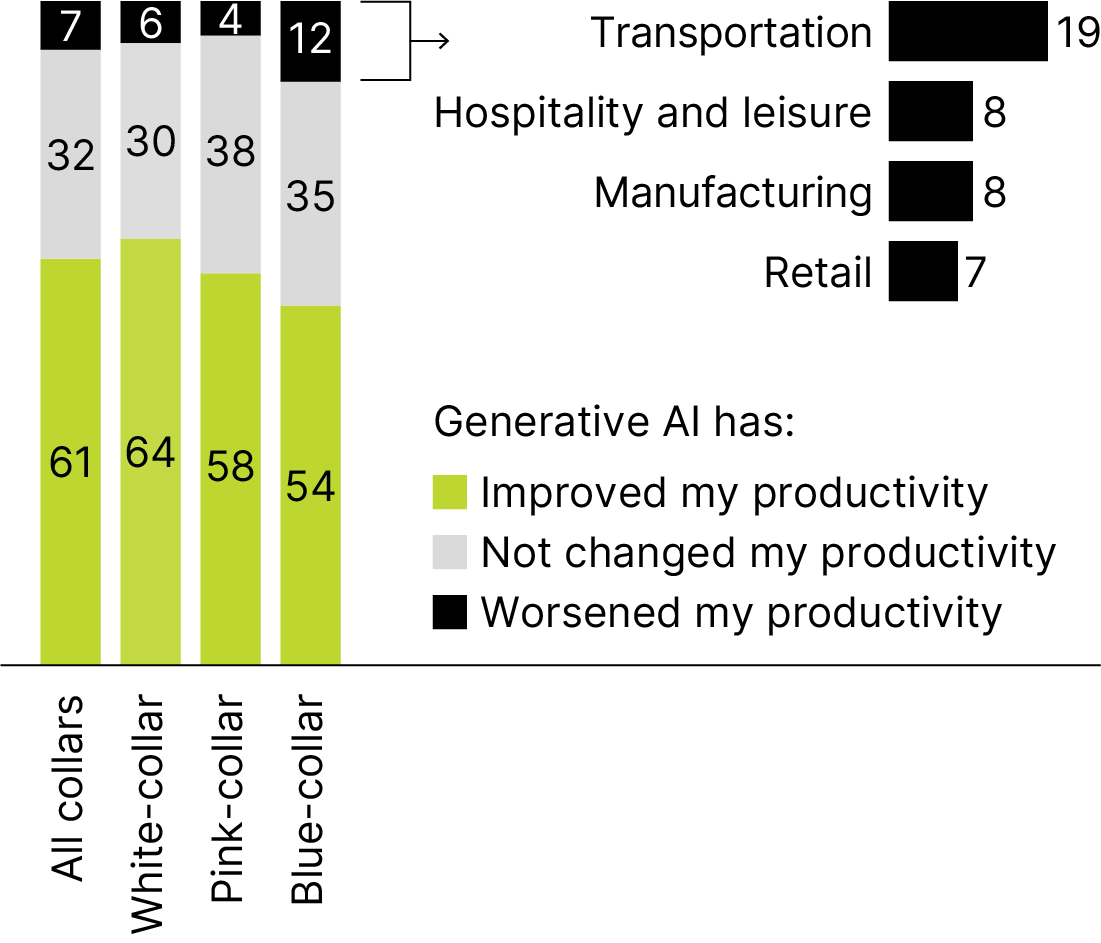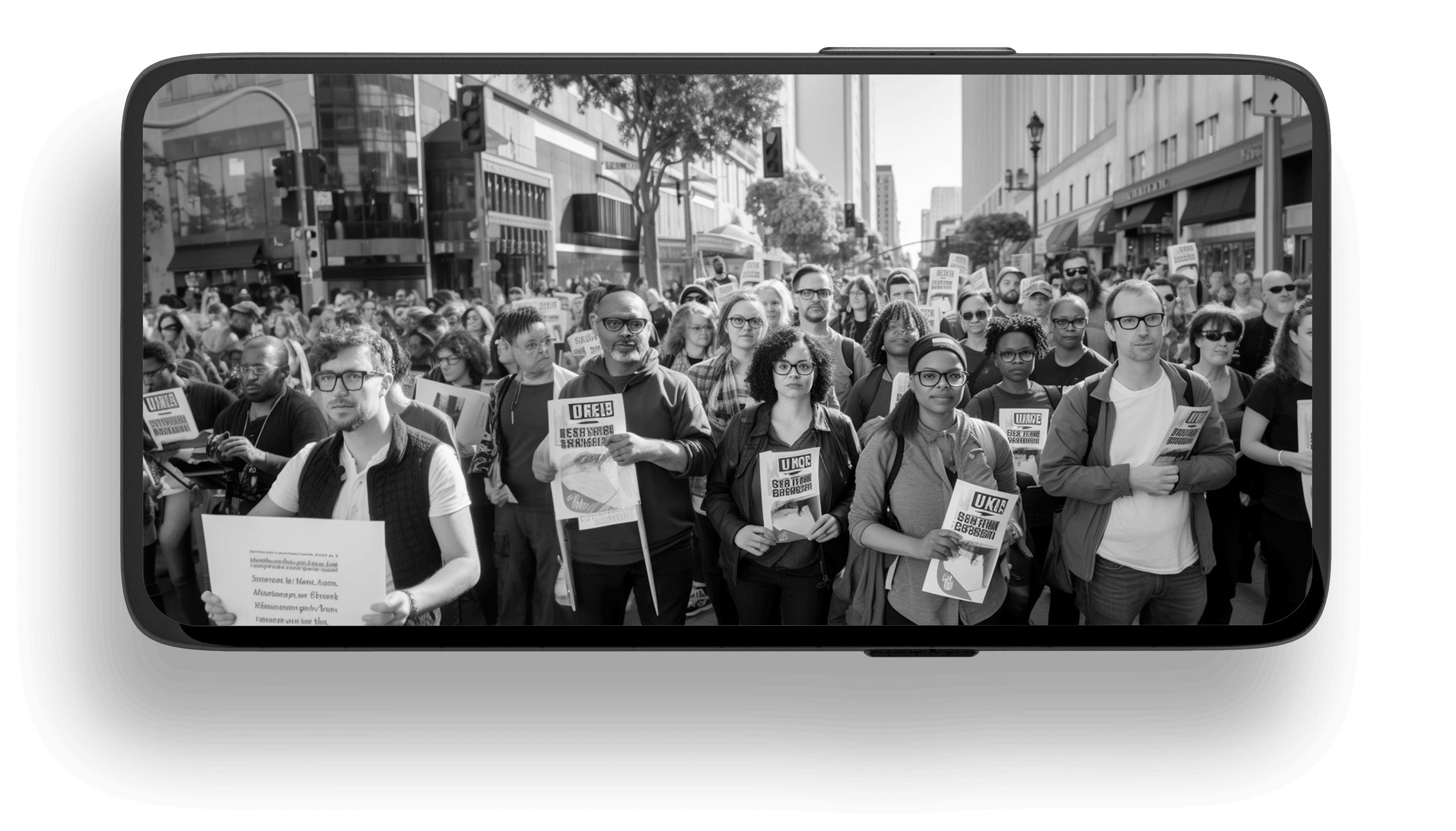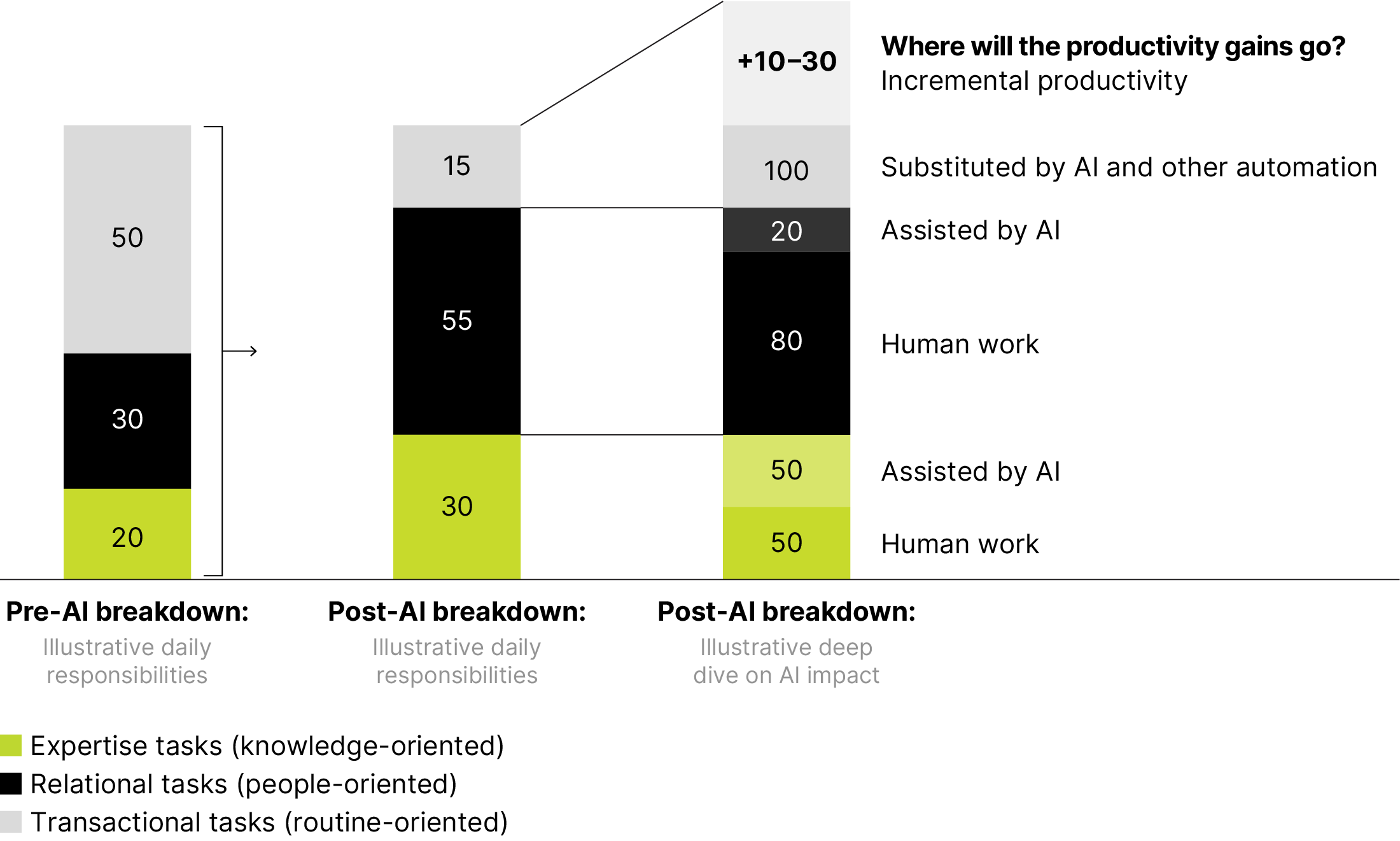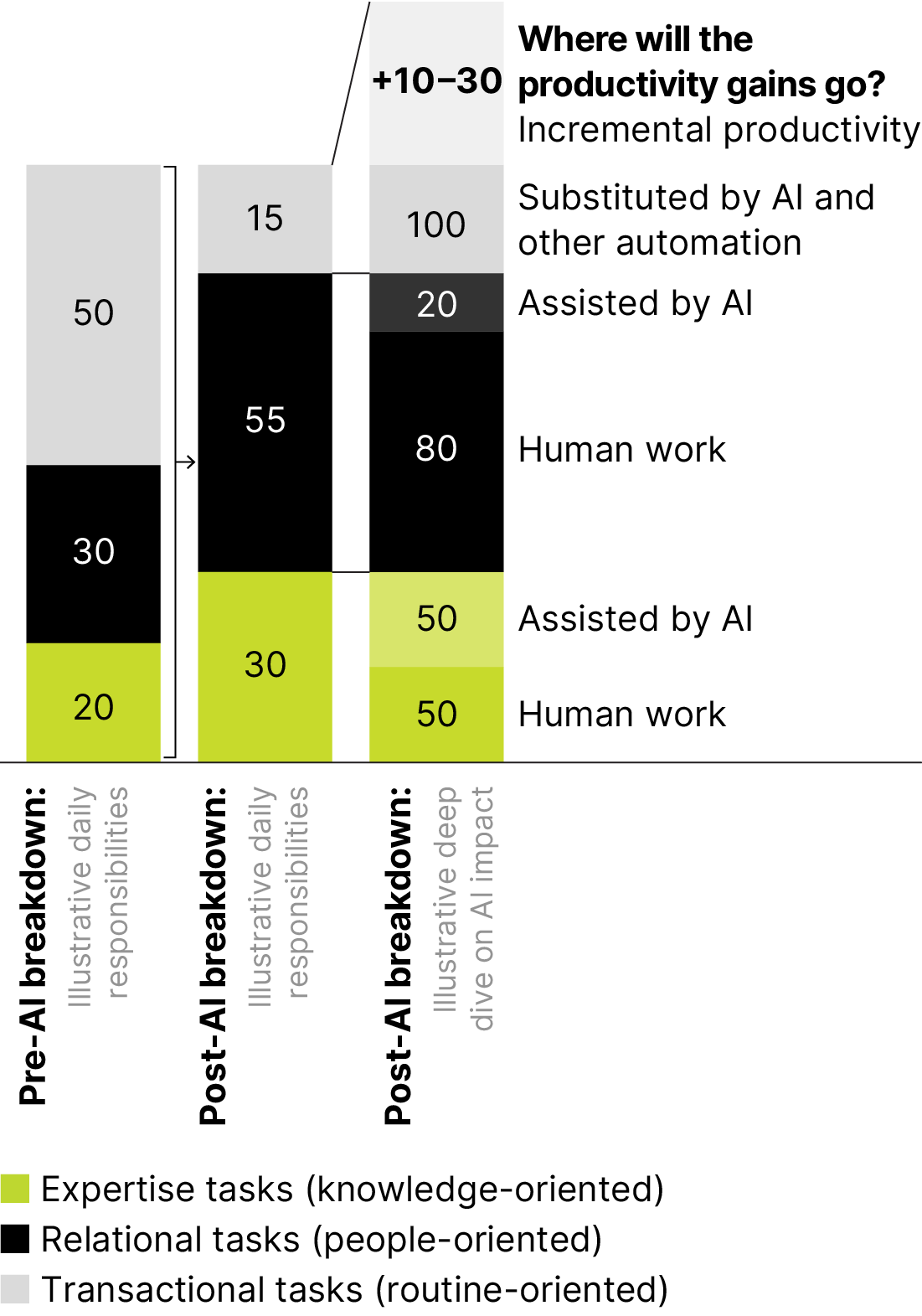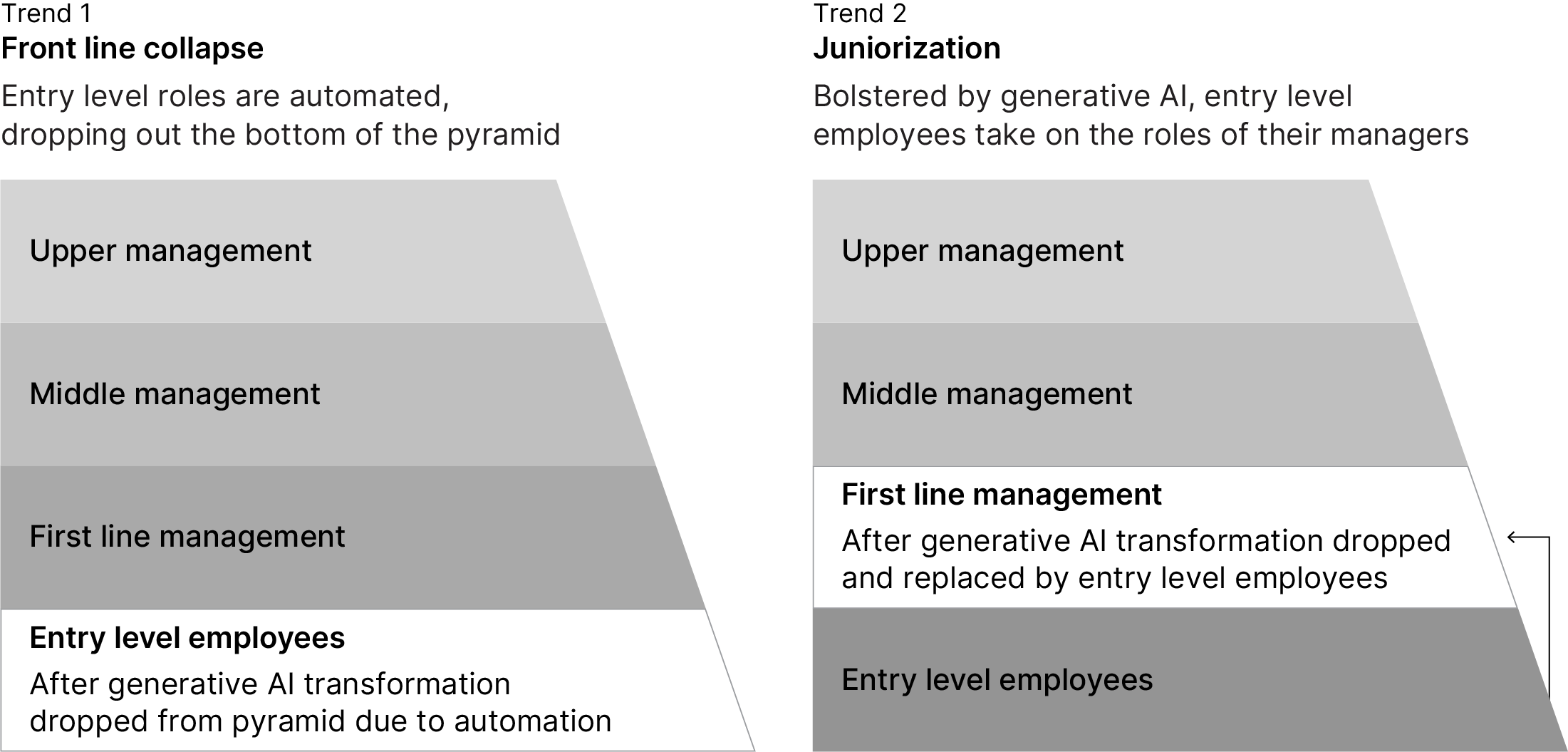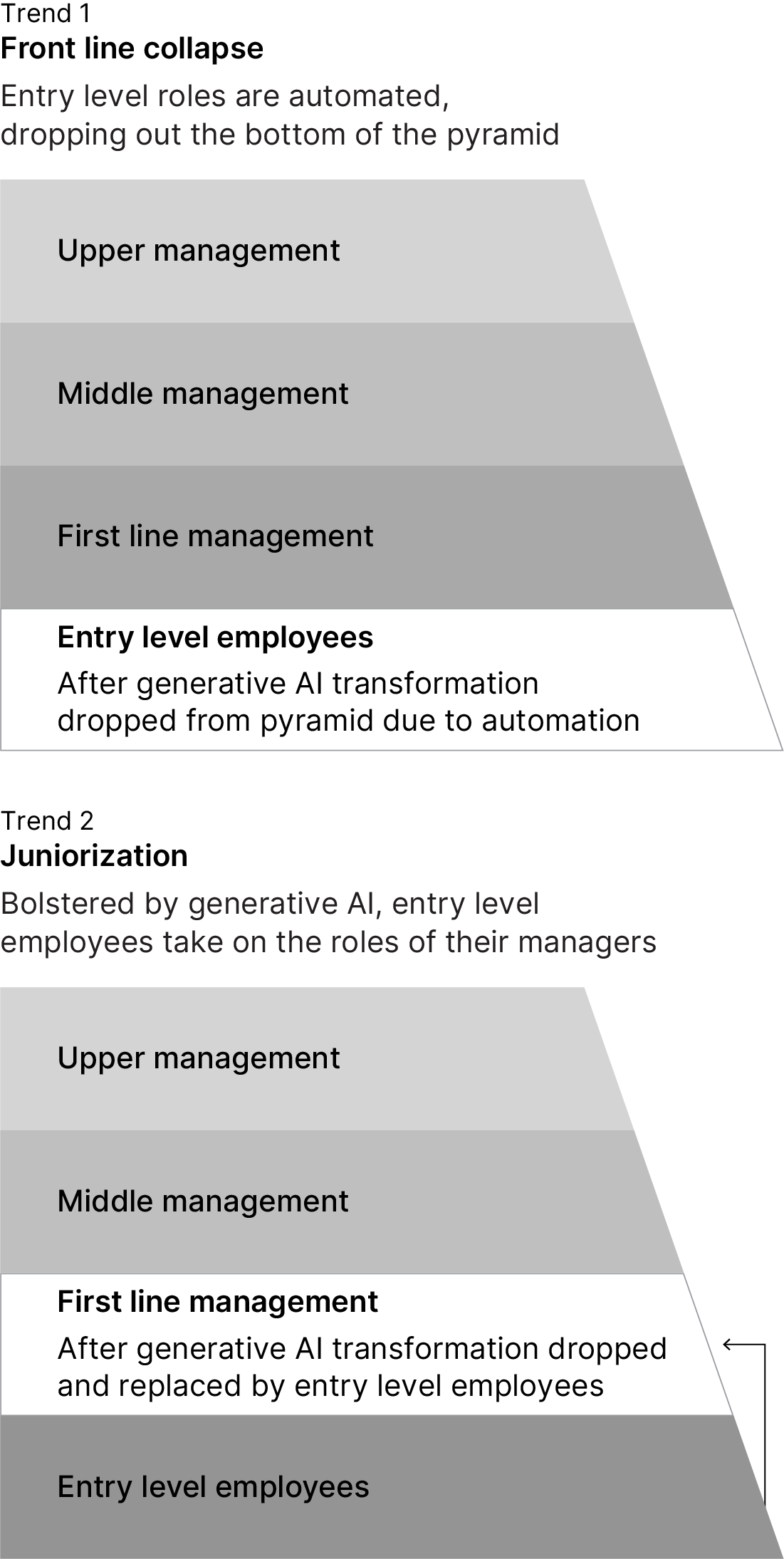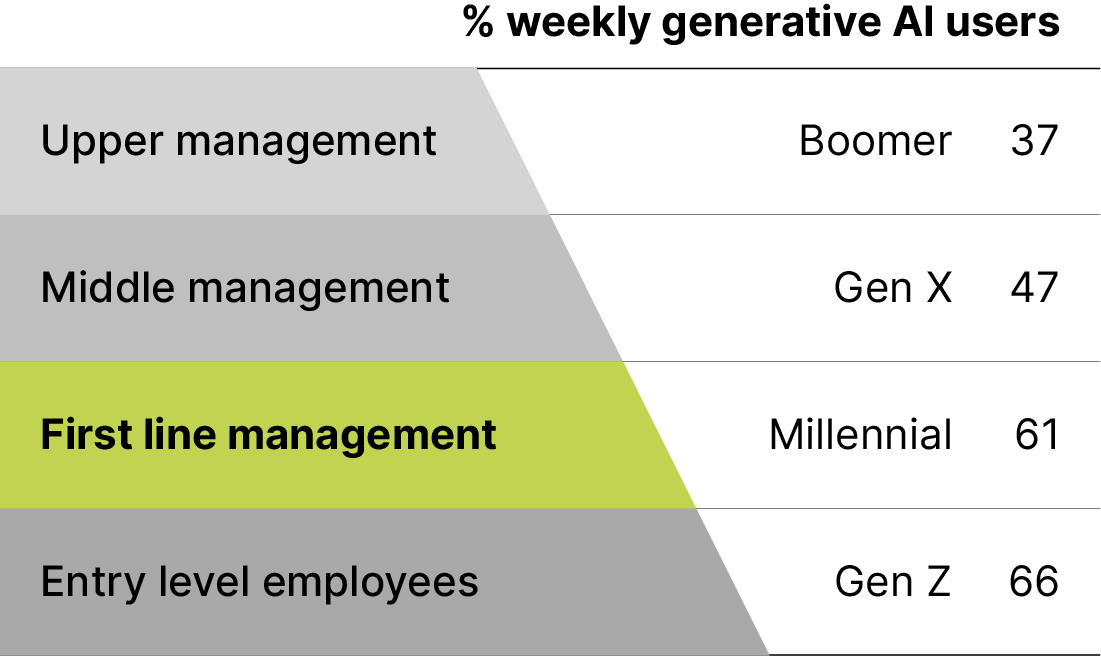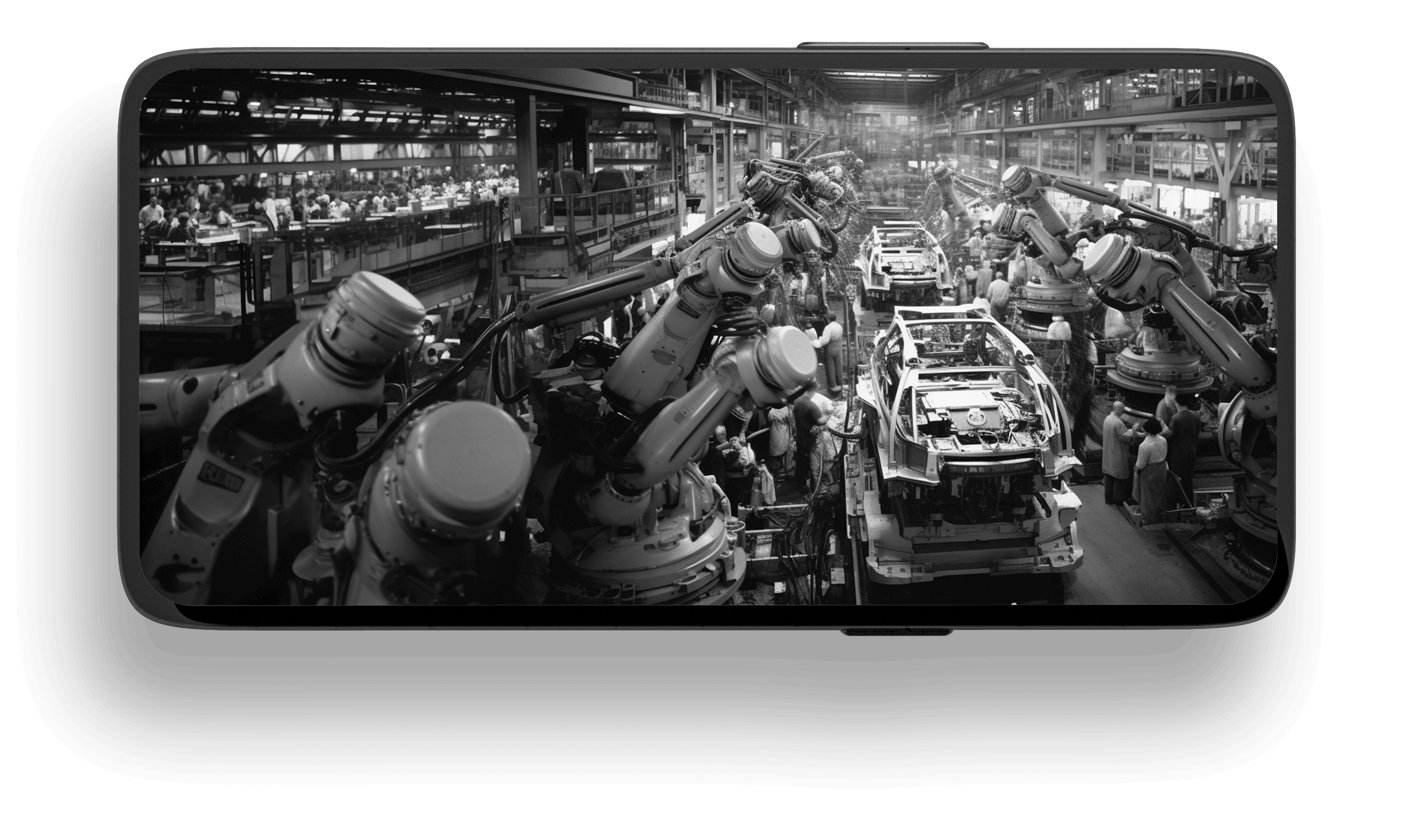How generative AI is changing the nature of work
Generative AI will likely transform workplaces across the global economy. It is eliciting a range of reactions — from optimism about unparalleled productivity gains and expanded creativity to fears about job loss and people’s sense of purpose.
Across industries, generative AI already is augmenting human capabilities. Legal firms use it to synthesize case law; marketers leverage it for targeted campaigns; scientists harness it to accelerate discoveries. However, mass adoption of generative AI does not automatically guarantee mass productivity. Some of the greatest historical innovations — from the printing press and the steam engine to electricity and the internet — revolutionized productivity even as they created new pitfalls. The industrial revolution propelled society forward yet bred employee exploitation and unrest, with owners reaping disproportionate gains. Early automotive advances enriched auto barons while displacing carriage drivers. The whale oil industry crumbled with Edison’s lightbulb, and who can forget when Netflix’s DVDs (and later streaming) dethroned Blockbuster?
Generative AI doesn’t just herald a surge in productivity; it invites a holistic re-examination of the very nature of work and the workforce and societal structures that support it. Business and government leaders need to balance progress with societal needs.
Some legs of this journey will seem familiar and some will be uncharted. Traditional technologies like computers and phones were more deterministic, with clear relationships between the inputs and the outputs. Generative AI’s self-learning algorithms bring a whole new world of complexity, leading to outcomes that are trickier to predict and manage.
Then again, companies have spent decades, even centuries, developing and perfecting ways to manage another unpredictable agent: people. Developing generative AI will require a bit of analog thinking alongside the purely digital — some human warmth alongside the cold precision, mixed in with lessons from people governance and management approaches applied to a world of co-piloting with machines. The ability to integrate human-like thinking, skills, and experience into the transformation led by generative AI will set successful companies apart in the years ahead.
Potential / Pitfalls
What is generative AI’s productivity potential, and how can employers and employees achieve it?
The potential: a golden age of productivity
Generative AI’s impact on productivity could be as transformative as the greatest historical leaps in innovation — akin to the revolutions of the printing press, internet, and the assembly line. Besides the potential effects on the global economy, generative AI could save 300 billion work hours each year as labor productivity soars.
At the same time, by automating routine and monotonous tasks, generative AI can provide workers more time to focus on the thoughtful and creative aspects of work. This emerging productivity paradigm could mark an era in which the value of work is measured by the novelty and ingenuity it fosters, creating possibilities for collaboration between humans and AI and breaking barriers on what we currently define as productivity.
Generative AI’s swift march across the global workforce
Even though generative AI has been around for more than 50 years, it wasn’t until ChatGPT’s launch that employees across industries and occupations embraced it with zeal. It took more than two decades for half of Americans to adopt smartphones, according to Pew Research, and almost twice as long for them to acquire electricity at home, according to the National Park Service. Yet in just months, ChatGPT and new generative AI tools have captured the attention of approximately half of the global workforce.
From nation to nation: generative AI’s reach beyond borders
Historically, new technologies like electricity, automobiles, and computers initially were clustered in certain regions, with slow acceptance by other geographies.
But generative AI’s global uptake has moved as quickly as viral media: Software programmers in India embrace it as readily as construction workers in Thailand or bankers in Brazil do.
In some nations, generative AI has become so deeply embedded into everyday tasks that it is almost as instinctive for people as checking email in the morning or taking that first sip of coffee before work. Propelled by the top-ranking AI skills penetration as tracked by the Organization for Economic Cooperation and Development, India has catapulted to an 83% weekly adoption rate across all employees we surveyed, slightly higher than the 75% reported by Slack’s State of Work Report. Meanwhile, governments in the United Arab Emirates (UAE) and Indonesia are showing strong commitment to generative AI through initiatives such as the National AI Strategy 2031 in the UAE and the National Strategy on AI 2020–2045 in Indonesia. Even in countries with low adoption like Australia and Canada, over a third of employees use generative AI at least once a week, and nearly 10% use it daily.
Generative AI breaks the speed limit across job types
The spread of generative AI is impressive not only in terms of geographic breadth but also speed of adoption across industries. From June to November, generative AI use exploded across all job types, with a 62% increase in use overall across white-, blue-, and pink-collar workers. More than one in three employees in industries with the lowest AI adoption report using it at least weekly, from healthcare workers to public sector officials.
This spread across all job types is unprecedented. Automation brought significant change to the manufacturing floor, where machines, with their unerring precision and tireless efficiency, replaced blue-collar workers. Meanwhile, white-collar professionals have had a different experience with technology. Their work, often less physical in nature, has historically been insulated from the robot revolution that transformed other sectors.
But generative AI is erasing these boundaries. Adoption is highest among white-collar workers as knowledge work is democratized: Nearly three in five white-collar employees report using generative AI on a weekly basis. It has brought a level of optimization and automation to tasks once thought to be immune to such disruption. Cutting-edge generative AI tools are even revolutionizing “human” tasks such as performance management.
Blue- and pink-collar workers are close behind. Nearly half report using generative AI weekly, defying expectations of lagging adoption. For example, employees in large supermarkets are now armed with personalized AI assistants that help automate the rote tasks of ordering supplies and writing reports. Truck drivers are using generative AI for load-to-driver matching, optimizing which cargo goes on which truck. In manufacturing industries, blue-collar workers are using generative AI to scan long repair manuals and instantly deliver the precise methods needed — a huge improvement from thumbing page-by-page for the right procedures. Generative AI’s rapid uptake comes amid widespread employee hopes for productivity benefits.
There has been a broad and substantial increase over the past few months in the belief that generative AI will have a positive impact on jobs, according to our November 2023 survey data. Previously hesitant or skeptical individuals are now a small minority, with most recognizing generative AI’s value proposition. In fact, more than 60% of organizations surveyed thought generative AI has the potential to deliver significant cost savings and improvements to operational effectiveness, according to an Oliver Wyman survey of UK financial institutions conducted in partnership with UK Finance. This isn’t merely about doing the same things faster; it's about enabling more to get done with less, redefining the potential of what can be achieved in a day's work.
Blue- and pink-collar workers also report having more faith lately: their belief in generative AI's benefits increased rapidly in just a few months to 94%.
Mass adoption ≠ mass productivity
The dramatic uptake in generative AI has been useful for many but hasn’t yet resulted in significant productivity gains across the board. Why?
A similar question was raised in 1987, when economist Robert Solow observed a disconnect between the burgeoning computer age and the anticipated productivity gains — an observation now known as “Solow’s paradox.” Businesses and governments poured money into IT infrastructure, yet the expected leap in productivity was conspicuously absent. This paradox left many wondering if the problem lay not with the capacity of the technology but rather with the manner of its implementation.
Fast forward to the present and the question returns: Could the productivity benefits from generative AI be slow to materialize, in a repeat of Solow’s paradox? Our estimates suggest that if generative AI deployment isn’t proactively managed, it risks becoming a productivity sinkhole in the short term, potentially squandering up to 200 billion hours of productivity annually.
Solow’s paradox suggests that strategic investments, systematic implementation and adoption (and some patience) are all necessary in harnessing transformative technologies. So where are we now?
Employees are still in early experimentation mode with generative AI, testing how to optimize their individual ways of working. The bottom-up individual adoption is mostly within existing individual processes and activities, rather than rethinking entire team activities or organizational ways of working. Generative AI’s true rewards of large-scale productivity transformation will likely require work to be restructured at an organizational level.
Perhaps that is why we already see a dissonance between some employees’ expectations and experiences: While many employees notice an improvement in productivity, more than one-third of generative AI-using employees report no change or a decline in productivity after adopting generative AI. Specifically, more than 10% of blue-collar workers perceive a decrease in productivity, with workers in some sectors, such as transportation, which is heavily reliant on efficiency and time management, reporting up to 19% productivity losses.
These figures represent the growing pains of a technological evolution. According to the study by Oliver Wyman and UK Finance, more than 70% of generative AI use cases at surveyed organizations were still in the proof-of-concept or pilot phase. While optimism remains a powerful force, it must be met with a commitment to strategic and thoughtful implementation.
Glamour meets grit
The allure of generative AI’s cutting-edge capabilities is undeniable, but the technology itself won’t guarantee success — that will come down to the unglamorous, meticulous processes underpinning its development, testing, and implementation.
The good news is that many of the current challenges with AI that employees identify are issues that can be potentially overcome with process changes. Many report incomplete knowledge as a large barrier, whether that is their own proficiency with the technology overall (22%) or learning how to prompt, review, and adapt the output (20%), highlighting a gap that needs bridging across all sectors of the workforce.
Moreover, productivity is sometimes limited because of imperfect collaboration. In the context of blue-collar work, where the orchestration of tasks is paramount, 22% of those reporting no productivity improvement with generative AI point to collaborator inefficiency.
So how do we drive more efficient adoption?
Companies need to consider both what individual workers need and how the anatomy of work will change.
When individual workers were introduced en masse to generative AI tools such as ChatGPT and DALL-E, the technologies were so intuitive that many first-time users assumed they (or their employees) could teach themselves. However, based on our data, less than one-third of generative AI users report employing best practices for use: Only 32% of generative AI-using employees say they use prompt engineering, and only 26% say they clean data before use with generative AI tools. Alarmingly, almost one in five report not using any best practices at all.
While this limits labor productivity, it provides an opportunity for targeted education, skill development, and recognition of workers who are upskilling themselves and their peers. Enabling a culture of informed enthusiasm and application, in which generative AI best practices are embedded in workflows, is critical to drive tangible labor productivity.
The second parallel step has to do with the anatomy of work. Leaders often focus on how generative AI and other technologies can reduce headcount. As a result, efforts to adopt generative AI may crash on the rocks of poorly conceived work design, potentially leading to a repetition of Solow’s paradox.
As businesses adopt generative AI, they should prioritize the work and not the technology. Organizations should first seek to understand the nature of work, then identify specific tasks where generative AI can enhance efficiency and thoughtfully redesign work processes based on the greatest opportunities for generative AI to drive outcomes. For example, generative AI can help substitute highly repetitive, rules-based work, creating room for greater human creativity, empathy, and critical thinking.
Leading with work can enable organizations to realize significant economic and other gains since optimal solutions for generative AI adoption are often visible only at the task and skill level. By making work design a core capability of the organization and continuously redesigning work to achieve the optimal combinations of talent and technology, businesses and their workforces can realize the full value of generative AI.
Catalyst / Collapse
Reinventing workforce structures
Reimagining a new job pyramid
As far back as the Elizabethan era and the Industrial Revolution, people anticipated and worried about how machines would affect their work. In 1850, a group of tailors in New York City threatened to strike unless their employer stopped using new sewing machines. Newspaper articles bemoaned the fate of the “poor girls” who would no longer make a living by sewing bags to store salt, and advised seamstresses to focus on more complex work that could never be touched by machines — sewing dresses. As we look back at this episode we might laugh at the specific advice, but the broad situation is all too analogous to what workers face today: We may not know exactly what parts of the workforce will be disrupted or how, but we know that there is about to be a shift. How do we predict or prepare?
Generative AI can transform the fundamental structure of work.
The effects of generative AI will be felt across all job levels, reconfiguring the job pyramid and reorganizing the skills hierarchy. Experts generally agree that entry level employees will likely be the first to experience the impact of generative AI. But junior employees today think that only a third of their roles could be automated, which is 25% less than what senior employees believe.
As some experts look at how employeesʹ current tasks will be affected by generative AI and automation, they divide the work into three types: transactional, relational, and expertise-related. Much of our transactional work will be substituted by a combination of robotic process automation, machine learning, and generative AI, while work requiring deep expertise or human collaboration will increasingly be augmented. The combination of these changes is likely to generate incremental productivity gains of 10–30%, according to authors Ravin Jesuthasan and John Boudreau as explored in their book “Work Without Jobs”. The question for leaders and governments is what will we do with these gains? Will we take them to the bottom line of corporations as we have done for much of the last 60 years, or will we share the gains with the workforce and communities, creating a new management and labor compact?
Entry level and front-line impact.
Let’s imagine a hypothetical global airline called AirConnect, known for its commitment to innovation and superior customer service. In response to the evolving workforce landscape, this airline expects to implement generative AI solutions. Its plan? To replace a significant portion of customer service representatives with generative AI-powered chatbots, autonomously capable of handling customer inquiries and aiding in bookings.
Entry-level customer service employees at AirConnect might not be aware of the imminent change. Under the radar, AirConnect’s engineers are developing a generative AI chatbot equipped with skills that could soon surpass their own. While the metamorphosis of generative AI is underway, it is imperative to convey this transformative vision to employees. The challenge is not unique to our fictional airline; it’s a realistic possibility of what real-world employers will face as generative AI reshapes the workforce.
Collapse of the middle… manager
As generative AI replaces some front-line roles, it will disrupt the pipeline of manager roles, akin to the “collapse of the middle” in the job pyramid. We can likely expect generative AI and AI more broadly to accelerate the timeline for climbing the career ladder as tasks typically given to entry-level employees are streamlined by AI.
At AirConnect, generative AI-powered customer service agents can tackle the mundane tasks of booking flights, providing flight information, and resolving routine issues. This transformation could enable some junior customer service agents, who once bore the weight of these routine tasks, to move up. Our data show that two in three Generation Z employees now report using generative AI on a weekly basis, 78% more than boomers. At AirConnect, this means junior employees could embrace new roles as “customer experience managers,” charged with tasks that build on AI-powered functions, such as resolving intricate customer requests, pampering VIP passengers, and orchestrating solutions for any unconventional travel challenges. In essence, they would take on responsibilities that were once exclusive to their supervisors.
Empowering junior employees could come at the expense of middle managers, who traditionally serve as candidates for upper management. With the rise of generative AI, AirConnect and other realworld organizations could find themselves confronting an unexpected conundrum: how to adequately develop its workforce for senior leadership.
The great reskilling — an employer and employee challenge
Entering the reskilling revolution
Executives believe 40% of their workforce will need reskilling or upskilling within the next five years due to generative AI, as reported by the IBM Institute for Business Value, while almost all surveyed employees (98%) believe they will need it. Those sobering figures suggest that anywhere from 1.4 billion to more than three billion people globally will need to learn new skills. Not only is the demand for fresh skills changing, but the expected half-life of any newly learned skill is now less than five years, according to Harvard Business Review. This presents a massive challenge for employers, employees, and public policy officials concurrent with a redefinition of job structures for the workforce of tomorrow.
The impact, however, is far from clear and uniform. Some employees will navigate uncharted territories, embracing new roles and workflows that don’t yet exist — managing the outputs produced by generative AI and delving into quintessentially “human” aspects of work. Others will learn generative AI skills that enable them to increase their productivity and automate tasks that were once arduous and repetitive.
Although companies and workers agree that technical and soft skills are important, they disagree on what those priorities should be. For example, surveyed employees rank AI and big data as their top reskilling priority, and almost three-quarters of them want more learning opportunities around these. However, employers rank AI and big data fourth behind soft skills such as creative thinking, leadership, and social influence, and only 41% of employers prioritize these crucial skills, according to the World Economic Forum.
This mismatch between what employees want and how much training their employers think they need is significant. Almost three out of five employees who receive reskilling opportunities report that they are inadequate, underscoring the growing discontent. In India, where the gap between employee demand for generative AI reskilling and employer offerings is smallest, 60% of surveyed employees nevertheless say existing learning opportunities remain inadequate.
This mismatch is consistent from knowledge workers to skilled laborers, with the largest gap occurring among pink-collar workers. Those surveyed are 30% more likely to desire reskilling opportunities in generative AI than they say their employers are willing to provide them. This gap extends to white-collar and blue-collar employees, and Gen X and boomer employees as well.
Gen Z employees, who are digital natives, along with many millennials, proactively seek opportunities to bolster their generative AI expertise. And while two in three boomers report they are seeking AI reskilling opportunities, debunking any notion that older workers may be averse to embracing new technology, they also say they are the most likely to lack access to generative AI learning opportunities due to lack of employer resources. The path to exposure and learning, as well as full upskilling and reskilling, will not look the same for every worker, underscoring the urgent need for employers across all industries to reprioritize and invest in their learning and development and broader reskilling agendas.
Preparing today for the workforce of tomorrow
If various estimates are correct, in the coming decade billions of workers will need upskilling and millions may need to be entirely reskilled. How do we address this complex business and societal challenge to enable a smooth labor force transition for not only those acquiring new skills but for those changing occupations?
Earlier, we introduced the notion of work design as a core capability of the organization, ensuring the optimal combinations of generative AI and human work. To navigate the transformative landscape to come, this capability should be accompanied by investments in talent development and deployment, requiring organizations to have a strategic and comprehensive approach to reskilling and upskilling initiatives.
Recognizing that one size does not fit all, businesses should curate learning resources specific to each role, tailoring experiences to individual needs. Simultaneously, employees can enhance proficiency and confidence in working alongside generative AI through directly applicable training, such as hands-on workshops.
Organization leaders should champion reskilling initiatives to ensure employees are aware of their importance. At the same time, every employee should be empowered to be their own leader in the reskilling process, including a renewed focus on both the hard skills needed to wield generative AI tools and essential soft skills such as communication and critical thinking. Collaborating with employees in decisions about training can encourage ownership over the learning process and ensure reskilling is effective for every employee.
Metamorphosis / Meltdown
Transition with heart: How can employers chart a “humane” journey into the generative AI epoch?
Charting a humane workforce journey
How to transition with heart?
As we consider the vast changes that may be ahead for workers and for the structures in which they conduct their jobs, it is natural to look back at similar changes that have occurred in the past. And indeed the challenge of humane workforce transitions is not unique to the present day or to AI specifically; labor movements have long been linked to the uncertainty associated with technological advancements. For example, in Lordstown, Ohio, in 1972, assembly workers at General Motors were pushed to keep up with new robots, triggering a 22-day strike that cost $150 million, according to The New York Times. Similarly, past technology adoption by a global retailer led to a strike in South America. Employees demonstrated in response to automation’s impacts, including decreased headcount and increased workload for the remaining employees. Ultimately, the retailer needed to change its automation strategy, centering change on employee well-being.
The recent strikes in the entertainment industry and elsewhere might suggest that AI will inevitably prompt similar responses from across the workforce. But technological change doesn’t always lead to unrest. For instance, when IKEA rolled out a new chatbot to handle customer inquiries in 2021, it also embraced a strategy of reskilling nearly 10,000 call center employees. These employees, who no longer needed to answer routine customer questions, transitioned to remote interior design adviser roles that have enabled a new source of revenue for the company.
These contrasting outcomes underscore the critical importance of adopting technology with a human-centric approach. By human-centric we mean actions that focus both on the rational dimensions of technology change — elements that optimize and enable the implementation of the technology itself — but also on the emotional aspects of change, which include empathetic leadership, enhancement of an organization’s cultural elements, and employee training.
Employees who experience a new technology as something that helps them to grow are much more likely to feel comfortable and to contribute fully to their workplace, and employers who are prepared to listen and motivate employees are more likely to avoid disruptions and even to expand. But as our assessment of employer and employee sentiment shows, many workplaces still have steps to take in order to achieve this humane transition.
Employer optimism is loud, employee concern is louder
Employees across industries agree more than ever on generative AI’s potential for the workforce, but at least half of surveyed employees don’t trust it. Almost one in three say they are stressed about using generative AI at work, and two in five say they are uncomfortable with generative AI tracking their work activities. Part of this owes to a perceived lack of communication and trust around generative AI plans as well as the lack of understanding and training described earlier. It may also be due to a disjuncture in the perceived readiness of organizations to adopt generative AI. Some 70% of non-CEO executive teams don’t believe their organization is ready to adopt generative AI responsibly, but 50% of CEOs say they are already integrating it into their products and services — suggesting the existence of workplaces where people are already transitioning to AI in a way that makes them uncomfortable.
This discomfort with the transition to AI may also be contributing to employees’ views about work more broadly. The American Psychological Association reported that US employees who expressed worry about the broad category of AI at work were 57% more likely to report feeling a decline in productivity and motivation than unconcerned employees. They were also much more likely to feel that they don’t matter to their employer or work community. These findings do not necessarily mean that worries about generative AI have caused worker malaise, but they do suggest an undercurrent of concern and disaffection that runs counter to the kind of purposeful change that would lead to effective adoption of AI.
Furthermore, beyond the emotional impacts of worries about AI, our data indicate that concerns about AI may well be contributing to employees’ decisions to leave their jobs. According to our survey, nearly one in three employees who say they are looking for new jobs say it is because of AI disruption. These AI-influenced job seekers are a meaningful percentage of overall job seekers across the countries we surveyed, contributing to the large numbers of respondents across the globe who say that they are searching for jobs for any reason. In some countries — notably India and the UAE — employees surveyed believe more than half of their own jobs could be automated, and over 40% of job-seeking employees there say their job search is motivated by generative AI.
Notably, while many historical examples of unrest are related to the anxieties of blue-collar workers, our data show that white-collar workers lead in automation fears about generative AI. Many white-collar workers surveyed across the globe report feeling threatened by generative AI’s reach into knowledge work. In industries like healthcare and education, white-collar workers are up to 30% more concerned than their blue- and pink-collar counterparts about automation. And this trend holds true across the countries we surveyed: An overwhelming 80% or more white-collar employees surveyed in the United Arab Emirates, India, and China (Hong Kong) report concern about generative AI automation.
Our survey shows that while automation anxiety is widespread, it is greater among younger employees. Because younger employees are also more likely to report they are currently using generative AI at work, they might be more acquainted with the transformative potential of generative AI than older employees, leading them to have greater concerns of job displacement. Our data show that two in three Gen Z employees now report using generative AI on a weekly basis, 78% more than boomers. Meanwhile, older employees might say they feel more secure in their jobs because they believe generative AI-driven workforce trends — such as the impact on entry-level and front-line workers and the collapse of the middle — will have a lesser impact on their higher levels in the job pyramid.
Beyond employees’ fears of job automation, they face another concern: When the gains from generative AI are realized, they may not be the ones who benefit. In 1930, economist John Maynard Keynes predicted that by 2030, people would work 15-hour weeks due to technical progress. Nearly a century later, rising living costs, income disparities, and uneven productivity gains have prevented this vision from becoming reality. Employers have often absorbed output gains and cost reductions from past automation, while employees have received increased workloads. Generative AI seems to continue this trend: While 61% of generative AI-using employees report increased productivity, only 53% have seen improved work-life balance. Already, one in four white- and blue-collar employees say generative AI has increased expectations to do more work.
Across all of these demographics, we are at a critical juncture in technological integration. Employees may feel removed from their jobs and even choose to leave them — but these are the very same employees who overwhelmingly believe that AI has the potential to benefit their current jobs and who are currently using AI on a weekly or even daily basis. It is natural for employees and employers alike to see both the promise and potential pitfalls of the changes associated with generative AI. Leaders have the opportunity to choose a positive path for navigating these transformative changes and helping employees feel supported. By engaging in active listening, demonstrating understanding, and addressing concerns, organizations can channel the capabilities of generative AI into constructive progress.
Five key principles to leading with heart through the generative AI transformation
How can companies press forward with generative AI adoption and create a more balanced and equitable future for all? As organizations seek to create a value-driven and human-centric future of work, the World Economic Forum’s Good Work Framework can serve as a call to action to lead with values and set bold ambitions around the “S” in businesses’ environmental, social, and governance (ESG) agendas.
The framework has key objectives for organizations that want to lead the charge on staying relevant, responsible, and relatable. It proposes a series of metrics and reporting guidelines to galvanize these commitments into action, including upskilling and reskilling programs, flexible work options across the organization, ensuring pay equity, and providing a living wage in the face of work that is perpetually being reinvented at scale and pace by generative AI.
Many companies are also weaving the World Economic Forum’s Good Work Framework into their employee value propositions. This trend aligns with Mercer’s recent Global Talent Trends Study, which found that employee experience is one of the top priorities in 2023 for human resources leaders. Now, 37% of HR leaders are actively designing work with wellbeing in mind (for example, realistic workloads, no-meeting days, reduced complexity, positive work environment, culture of trust, and so on). Of these, 46% are enabling workers to take paid time away from work for everyday life activities such as doctors’ appointments and school events. And 67% are building a culture in which employees feel comfortable bringing their authentic selves to work.
With the transformative power of generative AI poised to redefine the employee experience of work and the very essence of work itself, the need for organizations to lead with empathy and foresight has never been more urgent. Adapting the principles of the Good Work Framework can serve as a potential path forward for organizations to navigate this seismic shift, pioneer a seamless transition, and create a prosperous future. It is now incumbent on all organizations to heed the call, embrace the unprecedented changes ushered in by generative AI, and harness this technology to forge a brighter, more inclusive future for all.


